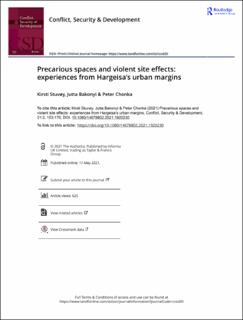Precarious spaces and violent site effects: experiences from Hargeisa’s urban margins
Peer reviewed, Journal article
Published version
Permanent lenke
https://hdl.handle.net/11250/3007775Utgivelsesdato
2021Metadata
Vis full innførselSamlinger
Originalversjon
Conflict, Security and Development. 2021, 21 (2), 153-176. 10.1080/14678802.2021.1920230Sammendrag
This paper addresses precarity from a spatial perspective. It draws attention to how power becomes inscribed in urban space and shapes particular spatial arrangements connected with socio-economic vulnerabilities. This is empirically illustrated with a case study of Hargeisa, a city historically marked by the violence of the Somali civil war. Our analysis draws on interviews and participant photography, to foreground the ‘everyday’ experiences of residents living in the city’s marginal settlements. We point to the operations of power that produce political, economic and social deprivation but also agentic options for these residents who experience, cope with, struggle with and work against their marginalisation. Interconnecting precarity with geographies of violence, we elaborate the concept of ‘violent site-effects’ as a means to explain how power inscribed in spatial arrangements can cause harm to people. We emphasise violence as built into structures and as part of social orders that produce precarity. This, we argue, provides a basis on which to reflect on the dynamic ways in which inequality, insecurity and thus, vulnerabilities, are produced and reproduced in the processes of urban reconstruction. Precarious spaces and violent site effects: experiences from Hargeisa’s urban margins
